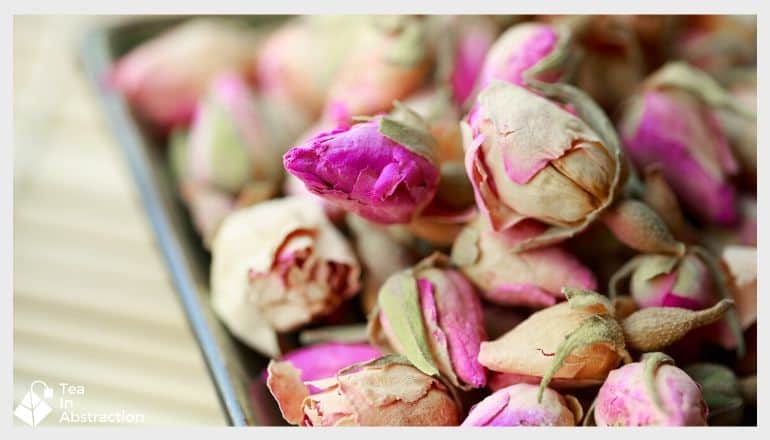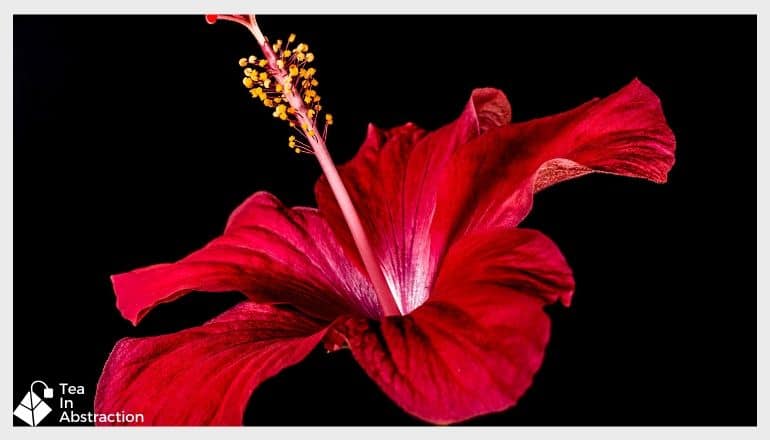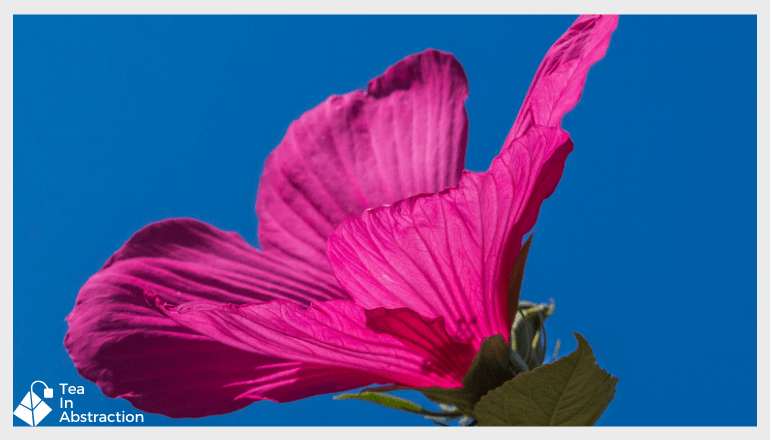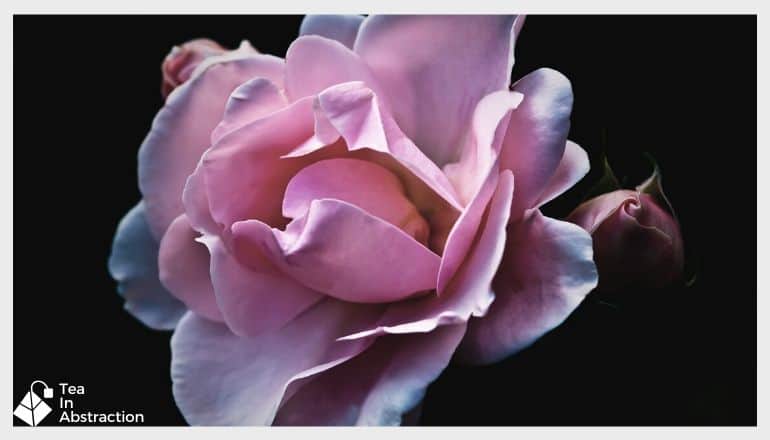*This Article May Contain Affiliate Links* See our Affiliate Disclosure for more Info
There is one simple prerequisite for enjoying a cup of hibiscus and rose tea. And that is you’ve got to love a flower herbal infusion. Because that is exactly what you were going to get. You were going to get a blast of Flowery floral flavor in every sip of this wonderful herbal infusion.
There are of course some nuances to the flavor profile, especially the flavor that the Hibiscus brings in but that flower flavor base is something you’ve got to be comfortable with from the first sip to the last.
What Is Hibiscus Rose Tea? Hibiscus rose tea is an herbal flower infusion that is created by taking hibiscus flowers and rose petals and steeping them in hot water for around 5 to 10 minutes.
One last thing I’d like to mention before we get into the bulk of the article is it is about rose and hibiscus tea and not rose hips and hibiscus tea. Rose petals and rose hips have a bit of a different flavor and are two different ingredients for Herbal infusions.

A Whole Lotta Rosy (And Hibiscus)
How To Make Hibiscus Rose Tea
A lot of making your cup of tea is all about how you like your tea made. Some people like to steep their tea a little bit longer others like to add sugar or milk to their tea. This is just the basic how to make a good cup of hibiscus rose tea and then you can customize it as you see fit on down the road.
You can use whatever instrument you feel comfortable with when creating your cup of hibiscus rose tea. If you want to use bag versions of this herbal infusion there are plenty of places to find it. You can use an infuser with the loose-leaf and create your cup of hibiscus rose tea that way.
And finally, you can just add the loose Rose and hibiscus flowers directly into the water and then strain it after it steep for a certain amount of time.
This last option is what I typically like to do with my loose leaf tea. I rarely use an infuser these days although I will on occasion. Again it’s personal preference there are some arguments against using infuser but I’m not sure I buy into them all that much.
I’ve never really noticed a big difference in the flavor of my tea when I use an infuser and when I just added to the water directly. But again some people might taste a huge difference.
And to be honest there’s only a slight flavor difference between using bag versions of the tea and using the loose leaf of the tea. Personally I think loose leaf taste a little bit better but there’s a lot of misdirected hatred out there for bagged teas that I think is a little bit over-the-top.
Most bag teas are going to taste just fine and the ones that I used for this article taste great in my opinion.
With all that said, let’s look at one of the more overlooked aspects of a great cup of tea, using proper water.
Need More Tea? Check Out Some More Of Our Articles…
Try And Use A Good Quality Water
One thing I always like to mention when making a cup of tea for yourself is to be cognizant of the type of water that you were going to use for that tea.
The water itself will affect the flavor of the finished tea. How much it affects it really depends on how delicate the tea is, to begin with. A very delicate sencha green tea is going to be impacted quite heavily by the type of water you used especially if you’re using something with heavy minerals or a distilled water where the flavor just becomes flat and pretty boring.
For our purposes where you want to look at how the water’s going to affect a hibiscus Rose herbal infusion. It’s not going to have the same effect that it does on the aforementioned green tea because the flavor of the Rose and the hibiscus is it going to be influenced as much by the water.
But it still matters and you should still try and get in the habit of using a good quality bottled spring water or filtered tap water as your go-to water for any cup of tea.
If you have just been using regular tap water and boiling it as most people do then I think using bottled spring water or filter tap water is really going to be a revelation on how much flavor you’ve been missing out on using a lesser quality of water.
Crafting Your Own Cup Of Rose Hibiscus Tea
These instructions should be viewed as simply a basic guide or starting point. Always adjust the amount of tea, the steep time and any other aspect to your personal tastes.
It is, after all, your cup of tea
- 1 teaspoon of loose leaf rose petals
- 1 teaspoon of loose hibiscus flowers
- Water temperature should be around 205°F/96°C
- A 5-10 minute steep time is a good place to start for this infusion but always adjust it to your personal tastes.
- Always Steep Your Tea Covered
You can substitute bagged versions of the tea as well. I recommend double the amount of water if you use one bag of each to keep the flavor consistent. But that is a personal choice.
Sweeten or add milk or cream as desired, but I personally don’t like to add calories to my herbal tea in any form. Again just personal preference.

What Should Rose And Hibiscus Tea Taste Like?
I find the flavor profile of rose and hibiscus tea to be fairly complex. It is certainly the sum of its two parts. You are going to find that the overwhelming flavor is the flowery flavor of both the rose petals and the hibiscus.
But the nuanced flavors of each one do come into play quite a bit. Let’s break down the flavor profile and see what to expect from this amazing herbal infusion.
It Is A Floral Tea
The base of the flavor profile for the Hibiscus rose tea is very much a floral one. Both hibiscus and Rose are flower herbal teas in their own rights and when you bring them together you do get an incredibly floral flavor profile.
I think the rose tea becomes the dominant flower flavor but the Hibiscus is still there in the background adding its own Floral flavor to the proceedings.
A Tangy And Tart Note
Where you are definitely going to taste the hibiscus tea is with the subtle tea and tart flavor notes that permeate throughout this herbal infusion. The tanginess is a Tell-Tale flavor of the Hibiscus and it’s not overwhelmed in this blend.
Rose Hibiscus Tea Is Slightly Sweet
There is a subtle natural sweetness to hibiscus rose tea. It’s important to distinguish between sweet and sugary when you’re talking about herbal infusions. This is not a sugary sweet flavor it’s just a natural little bit of sweetness that lingers on your tongue every sip you take.
A Touch Of An Earthy Flavor
I don’t think any flower herbal infusion would be complete without a bit of earthy base to the flavor profile. This is a slight bit of Earth or bitterness that usually comes at the end of the sip of tea.
The earthy flavor for Rose hibiscus tea is very subtle and almost not noticeable unless you really attuned to drinking these types of herbal teas.
However, if you over steep the tea then this earthy bitterness can really get a little bit overwhelming. The good news is very hard to over steep your rose hibiscus tea.
The Hibiscus Rose Tea Aroma
Unsurprisingly the aroma of the Hibiscus rose tea is very much a floral smell. I think the rose Aroma really defines the overall smell of this particular herbal infusion.

Related Questions
Here are a few frequently asked questions about Rose and hibiscus tea that I think are pretty relevant to the overall experience of drinking this herbal infusion.
Does Hibiscus Rose Tea Have Caffeine?
Hibiscus rose tea is naturally caffeine-free. This makes it a great option to have when you’re concerned about caffeine interrupting your sleep habits or you just don’t want to feel jittery from the side effects of caffeine.
Keep in mind that if you add a real tea like a green tea or a black tea to this blend that will introduce caffeine into the mix.
Is Rose Hibiscus Tea Calorie And Carbohydrate Free?
Both rose tea and hibiscus tea are calorie and carbohydrate free so when you mix them together they stay carbohydrate and calorie-free.
However, adding any sugar milk or cream or anything else with calories will take away the calorie and carbohydrate-free benefit that you get from this herbal infusion.
If you must add sugar to your rose hibiscus tea blend to make it palatable, try and use a little as possible.
Where Can You Find Loose Leaf Hibiscus And Rose For Your Tea?
Here are a couple of places to find loose-leaf hibiscus and rose tea separately. Rose and hibiscus tea is not that abundant pre-packaged. So buying each ingredient and blending them yourself is the best way to go.
Loose Leaf Rose Tea
For a fine loose leaf rose tea I recommend Herbaila Red Rose Bud And Petals Tea(*affiliate link) available on Amazon.
Loose-Leaf Hibiscus Tea
My go-to brand of loose leaf hibiscus tea is probably Frontier Co-op Organic Hibiscus Tea(*affiliate link). You can find it on Amazon.
I also put together a list of 10 of the best hibiscus teas. these are obviously my personal opinion but you can check them out and see if any of them are going to be good for you. The list includes both bagged and loose-leaf versions and it’s a great place to look if you want more options for your hibiscus teas.

The Hibiscus Rose Tea Finish
That brings us to the end of our look at hibiscus and rose tea. I mentioned it up top and I mentioned it again here if you don’t like a really floral, flowery herbal infusion than you are not going to enjoy this tea, I do not think.
But for those that like a nice heavily flower flavored tea than this might be just up your alley you get the best of rose tea and it’s wonderful Rose Flower flavor and you get the Tangy slightly sweet hibiscus mixed in with it that Smooths out the flavor profile and makes that cup of tea just that little bit more flavorful and drinkable.
the best thing to do is to give it a try and see what you think of it. Some people are going to love it others are going to hate it and some people are just going to say “Meh”.
Hopefully, this article is giving you some ideas of what to expect from your cup of rose hibiscus tea a place to start in crafting not only this herbal blend but any new ones that you might think of.
Thank you for stopping by and have a wonderful day.